Genetic Characterization of Puccinia striiformis f. sp. tritici Populations from Different Wheat Cultivars Using Simple Sequence Repeats
Abstract
:1. Introduction
2. Materials and Methods
2.1. Field Experiment and Disease Assessment Sampling
2.2. Isolation and Reproduction of Isolates
2.3. DNA Extraction and SSRs
2.4. Population Genetic Analysis
2.5. Statistical Analysis
3. Results
3.1. Occurrence of Pst in Sampling Locations
3.2. Analysis of Genetic Diversity in Pst Populations
3.3. Recombination Test
3.4. Phylogenetic Relationship and Population Structure
3.5. Genetic Differentiation within and between Populations
3.6. Minimum Spanning Network for the MLGs
4. Discussion
5. Conclusions
Supplementary Materials
Author Contributions
Funding
Institutional Review Board Statement
Informed Consent Statement
Data Availability Statement
Conflicts of Interest
References
- Beddow, J.M.; Pardey, P.G.; Chai, Y.; Hurley, T.M.; Kriticos, D.J.; Braun, H.J.; Park, R.F.; Cuddy, W.S.; Yonow, T. Research investment implications of shifts in the global geography of wheat stripe rust. Nat. Plants 2015, 1, 15132. [Google Scholar] [CrossRef] [PubMed]
- Chen, X.M. Pathogens which threaten food security: Puccinia striiformis, the wheat stripe rust pathogen. Food Secur. 2020, 12, 239–251. [Google Scholar] [CrossRef]
- Chen, W.; Wellings, C.; Chen, X.; Kang, Z.; Liu, T. Wheat stripe (yellow) rust caused by Puccinia striiformis f. sp. tritici. Mol. Plant Pathol. 2014, 15, 433–446. [Google Scholar] [CrossRef] [PubMed]
- Li, Z.Q.; Zeng, S.M. Wheat Rusts in China; China Agriculture Press: Beijing, China, 2002. [Google Scholar]
- Ma, Z.H. Researches and control of wheat stripe rust in China. J. Plant Prot. 2018, 45, 1–6. [Google Scholar]
- Omara, R.I.; Shahin, A.A.; Ahmed, S.M.; Mostafa, Y.S.; Alamri, S.A.; Hashem, M.; Elsharkawy, M.M. Wheat resistance to stripe and leaf rusts conferred by introgression of slowrusting resistance genes. J. Fungi 2021, 7, 622. [Google Scholar] [CrossRef]
- Wellings, C.R.; Boyd, L.A.; Chen, X.M. Resistance to stripe rust in wheat: Pathogen biology driving resistance breeding. In Disease Resistance in Wheat; Sharma, I., Ed.; CAB International: London, UK, 2012; pp. 63–83. [Google Scholar]
- Ellis, J.G.; Lagudah, E.S.; Spielmeyer, W.; Dodds, P.N. The past, present and future of breeding rust resistant wheat. Front. Plant Sci. 2014, 5, 641. [Google Scholar] [CrossRef] [PubMed] [Green Version]
- McDonald, B.A.; Linde, C. Pathogen population genetics, evolutionary potential, and durable resistance. Annu. Rev. Phytopathol. 2002, 40, 349–379. [Google Scholar] [CrossRef] [PubMed] [Green Version]
- Grünwald, N.J.; Everhart, S.E.; Knaus, B.J.; Kamvar, Z.N. Best practices for population genetic analyses. Phytopathology 2017, 107, 1000–1010. [Google Scholar] [CrossRef] [PubMed] [Green Version]
- Fang, C.T. Physiologic specialization of Puccinia glumarum Erikss. and Henn. in China. Phytopathology 1944, 34, 1020–1024. [Google Scholar]
- Chen, C.Q.; Zheng, W.M.; Buchenauer, H.; Huang, L.L.; Lu, N.H.; Kang, Z.S. Isolation of microsatellite loci from expressed sequence tag library of Puccinia striiformis f. sp. tritici. Mol. Ecol. Resour. 2009, 9, 236–238. [Google Scholar] [CrossRef]
- Wan, A.; Zhao, Z.; Chen, X.; He, Z.; Jin, S.; Jia, Q.; Yao, G.; Yang, J.; Wang, B.; Li, G.; et al. Wheat stripe rust epidemic and virulence of Puccinia striiformis f. sp. tritici in China in 2002. Plant Dis. 2004, 88, 896–904. [Google Scholar] [CrossRef] [PubMed] [Green Version]
- Gad, M.A.A.; Li, H.X.; Alam, M.A.; Sajjad, M.; Li, M.J. Geographical distribution and virulence phenotypes of Puccinia striiformis f. sp. tritici from wheat in Yunnan, China. Scienceasia 2019, 45, 572–580. [Google Scholar] [CrossRef] [Green Version]
- Gangwar, O.P.; Kumar, S.; Bhardwaj, S.C.; Prasad, P.; Kashyap, P.L.; Khan, H.; Singh, G.P.; Savadi, S. Virulence and molecular diversity among Puccinia striiformis f. sp. tritici pathotypes identified in India between 2015 and 2019. Crop Prot. 2021, 148, 105717. [Google Scholar] [CrossRef]
- Linde, C.C. Population genetic analyses of plant pathogens: New challenges and opportunities. Australas. Plant Pathol. 2010, 39, 23–28. [Google Scholar] [CrossRef]
- Enjalbert, J.; Duan, X.; Leconte, M.; Hovmøller, M.S.; De Vallavieille-Pope, C. Genetic evidence of local adaptation of wheat yellow rust (Puccinia striiformis f. sp. tritici) within France. Mol. Ecol. 2005, 14, 2065–2073. [Google Scholar] [CrossRef]
- Mboup, M.; Leconte, M.; Gautier, A.; Wan, A.M.; Chen, W.; de Vallavieille-Pope, C.; Enjalbert, J. Evidence of genetic recombination in wheat yellow rust populations of a Chinese oversummering area. Fungal Genet. Biol. 2009, 46, 299–307. [Google Scholar] [CrossRef]
- Liang, J.; Liu, X.; Li, Y.; Wan, Q.; Ma, Z.; Luo, Y. Population genetic structure and the migration of Puccinia striiformis f. sp. tritici between the Gansu and Sichuan Basin populations of China. Phytopathology 2016, 106, 192–201. [Google Scholar] [CrossRef] [Green Version]
- Liang, J.; Liu, X.; Tsui, C.; Ma, Z.; Luo, Y. Genetic structure and asymmetric migration of wheat stripe rust pathogen in western epidemic areas of China. Phytopathology 2021, 111, 1252–1260. [Google Scholar] [CrossRef]
- Enjalbert, J.; Duan, X.; Giraud, T.; Vautrin, D.; De Vallavieille-Pope, C.; Solignac, M. Isolation of twelve microsatellite loci, using an enrichment protocol, in the phytopathogenic fungus Puccinia striiformis f. sp. tritici. Mol. Ecol. Notes 2002, 2, 563–565. [Google Scholar] [CrossRef]
- Bahri, B.; Leconte, M.; de Vallavieille-Pope, C.; Enjalbert, J. Isolation of ten microsatellite loci in an EST library of the phytopathogenic fungus Puccinia striiformis f. sp. tritici. Conserv. Genet. 2009, 10, 1425–1428. [Google Scholar] [CrossRef]
- Hu, X.; Ma, L.; Liu, T.; Wang, C.; Peng, Y.; Pu, Q.; Xu, X. Population genetic analysis of Puccinia striiformis f. sp. tritici suggests two distinct populations in Tibet and the other regions of China. Plant Dis. 2017, 101, 288–296. [Google Scholar] [CrossRef] [PubMed] [Green Version]
- Liu, T.; Bai, Q.; Wang, M.; Li, Y.; Wan, A.; See, D.R.; Xia, C.; Chen, X. Genotyping Puccinia striiformis f. sp. tritici isolates with SSR and SP-SNP markers reveals dynamics of the wheat stripe rust pathogen in the United States from 1968 to 2009 and identifies avirulence-associated markers. Phytopathology 2021, 111, 1828–1839. [Google Scholar] [CrossRef]
- Zhan, G.; Zhuang, H.; Wang, F.; Wei, G.; Huang, L.; Kang, Z. Population genetic diversity of Puccinia striiformis f. sp. tritici on different wheat varieties in Tianshui, Gansu Province. World J. Microbiol. Biotechnol. 2013, 29, 173–181. [Google Scholar] [CrossRef]
- Chu, B.; Yuan, K.; Wang, C.; Yang, L.; Jiang, B.; Gu, Y.; Ma, Z. Effects of wheat cultivar mixtures on population genetic structure of puccinia striiformis f. sp. tritici. PhytoFrontiers 2021, 1, 339–353. [Google Scholar] [CrossRef]
- Kamvar, Z.N.; Amaradasa, B.S.; Jhala, R.; McCoy, S.; Steadman, J.R.; Everhart, S.E. Population structure and phenotypic variation of Sclerotinia sclerotiorum from dry bean (Phaseolus vulgaris) in the United States. PeerJ 2017, 5, e4152. [Google Scholar] [CrossRef] [PubMed] [Green Version]
- Zeng, S.M.; Luo, Y. Long-distance spread and interregional epidemics of wheat stripe rust in China. Plant Dis. 2006, 90, 980–988. [Google Scholar] [CrossRef] [Green Version]
- Liang, J.; Wan, Q.; Luo, Y.; Ma, Z. Population genetic structures of Puccinia striiformis in Ningxia and Gansu provinces of China. Plant Dis. 2013, 97, 501–509. [Google Scholar] [CrossRef] [Green Version]
- Wang, S.; Chu, B.; Liu, Q.; Luo, Y.; Ma, Z. Development of a sequence-characterized amplified region marker using inter-simple sequence repeats for detection of Puccinia striiformis f. sp. tritici. J. Phytopathol. 2017, 165, 442–447. [Google Scholar] [CrossRef]
- Cheng, P.; Chen, X.; Xu, L.; See, D. Development and characterization of expressed sequence tag-derived microsatellite markers for the wheat stripe rust fungus Puccinia striiformis f. sp. tritici. Mol. Ecol. Resour. 2012, 12, 779–781. [Google Scholar]
- Zhan, G.M.; Wang, F.P.; Luo, H.Y.; Jiang, S.C.; Zheng, W.M.; Huang, L.L.; Kang, Z.S. Screening for simple sequence repeat markers in Puccinia striiformis tritici based on genomic sequence. J. Zhejiang Univ. Sci. B 2015, 16, 727–732. [Google Scholar] [CrossRef] [Green Version]
- Holland, M.M.; Parson, W. GeneMarker® HID: A reliable software tool for the analysis of forensic STR data. J. Forensic Sci. 2011, 56, 29–35. [Google Scholar] [CrossRef] [PubMed]
- Peakall, R.; Smouse, P.E. GenAlEx 6.5: Genetic analysis in Excel. Population genetic software for teaching and research—An update. Bioinformatics 2012, 28, 2537–2539. [Google Scholar] [CrossRef] [PubMed] [Green Version]
- Kamvar, Z.N.; Tabima, J.F.; Grünwald, N.J. Poppr: An R package for genetic analysis of populations with clonal, partially clonal, and/or sexual reproduction. PeerJ 2014, 2, e281. [Google Scholar] [CrossRef] [PubMed] [Green Version]
- Shannon, C.E. A mathematical theory of communication. Bell Syst. Tech. J. 1948, 27, 379–423. [Google Scholar] [CrossRef] [Green Version]
- Grünwald, N.J.; Goodwin, S.B.; Milgroom, M.G.; Fry, W.E. Analysis of genotypic diversity data for populations of microorganisms. Phytopathology 2003, 93, 738–746. [Google Scholar] [CrossRef] [Green Version]
- Ludwig, J.A.; Reynolds, J.F. Statistical Ecology: A Primer on Methods and Computing; John Wiley and Sons: New York, NY, USA, 1988. [Google Scholar]
- Nei, M. Estimation of average heterozygosity and genetic distance from a small number of individuals. Genetics 1978, 89, 583–590. [Google Scholar] [CrossRef]
- Agapow, P.M.; Burt, A. Indices of multilocus linkage disequilibrium. Mol. Ecol. Notes 2001, 1, 101–102. [Google Scholar] [CrossRef]
- Nei, M.; Tajima, F.; Tateno, Y. Accuracy of estimated phylogenetic trees from molecular data. II. Gene frequency data. J. Mol. Evol. 1983, 19, 153–170. [Google Scholar] [CrossRef]
- Pritchard, J.K.; Stephens, M.; Donnelly, P. Inference of population structure using multilocus genotype data. Genetics 2000, 155, 945–959. [Google Scholar] [CrossRef]
- Evanno, G.; Regnaut, S.; Goudet, J. Detecting the number of clusters of individuals using the software STRUCTURE: A simulation study. Mol. Ecol. 2005, 14, 2611–2620. [Google Scholar] [CrossRef] [Green Version]
- Earl, D.A.; von Holdt, B.M. STRUCTURE HARVESTER: A website and program for visualizing STRUCTURE output and implementing the Evanno method. Conserv. Genet. Resour. 2012, 4, 359–361. [Google Scholar] [CrossRef]
- Excoffier, L.; Smouse, P.E.; Quattro, J.M. Analysis of molecular variance inferred from metric distances among DNA haplotypes: Application to human mitochondrial DNA restriction data. Genetics 1992, 131, 479–491. [Google Scholar] [CrossRef] [PubMed]
- Bruvo, R.; Michiels, N.K.; D’Souza, T.G.; Schulenburg, H. A simple method for the calculation of microsatellite genotype distances irrespective of ploidy level. Mol. Ecol. 2004, 13, 2101–2106. [Google Scholar] [CrossRef] [PubMed]
- Jaimes, Y.; Gonzalez, C.; Rojas, J.; Rivera, J.J.; Cilas, C.; Argout, X. Population structure of Moniliophthora perniciosa in the main cacao producing departments of Colombia. Plant Dis. 2022, 106, 1492–1501. [Google Scholar] [CrossRef] [PubMed]
- Tollenaere, C.; Susi, H.; Laine, A.L. Evolutionary and epidemiological implications of multiple infection in plants. Trends Plant Sci. 2016, 21, 80–90. [Google Scholar] [CrossRef] [PubMed]
- Thrall, P.H.; Burdon, J.J. Evolution of virulence in a plant host-pathogen metapopulation. Science 2003, 299, 1735–1737. [Google Scholar] [CrossRef] [PubMed] [Green Version]
- Thrall, P.H.; Laine, A.L.; Ravensdale, M.; Nemri, A.; Dodds, P.N.; Barrett, L.G.; Burdon, J.J. Rapid genetic change underpins antagonistic coevolution in a natural host-pathogen metapopulation. Ecol. Lett. 2012, 15, 425–435. [Google Scholar] [CrossRef] [Green Version]
- Jin, Y.; Szabo, L.J.; Carson, M. Century-old mystery of Puccinia striiformis life history solved with the identification of Berberis as an alternate host. Phytopathology 2010, 100, 432–435. [Google Scholar] [CrossRef] [Green Version]
- Zhao, J.; Wang, M.; Chen, X.; Kang, Z. Role of Alternate hosts in epidemiology and pathogen variation of cereal rusts. Annu. Rev. Phytopathol. 2016, 54, 207–228. [Google Scholar] [CrossRef]
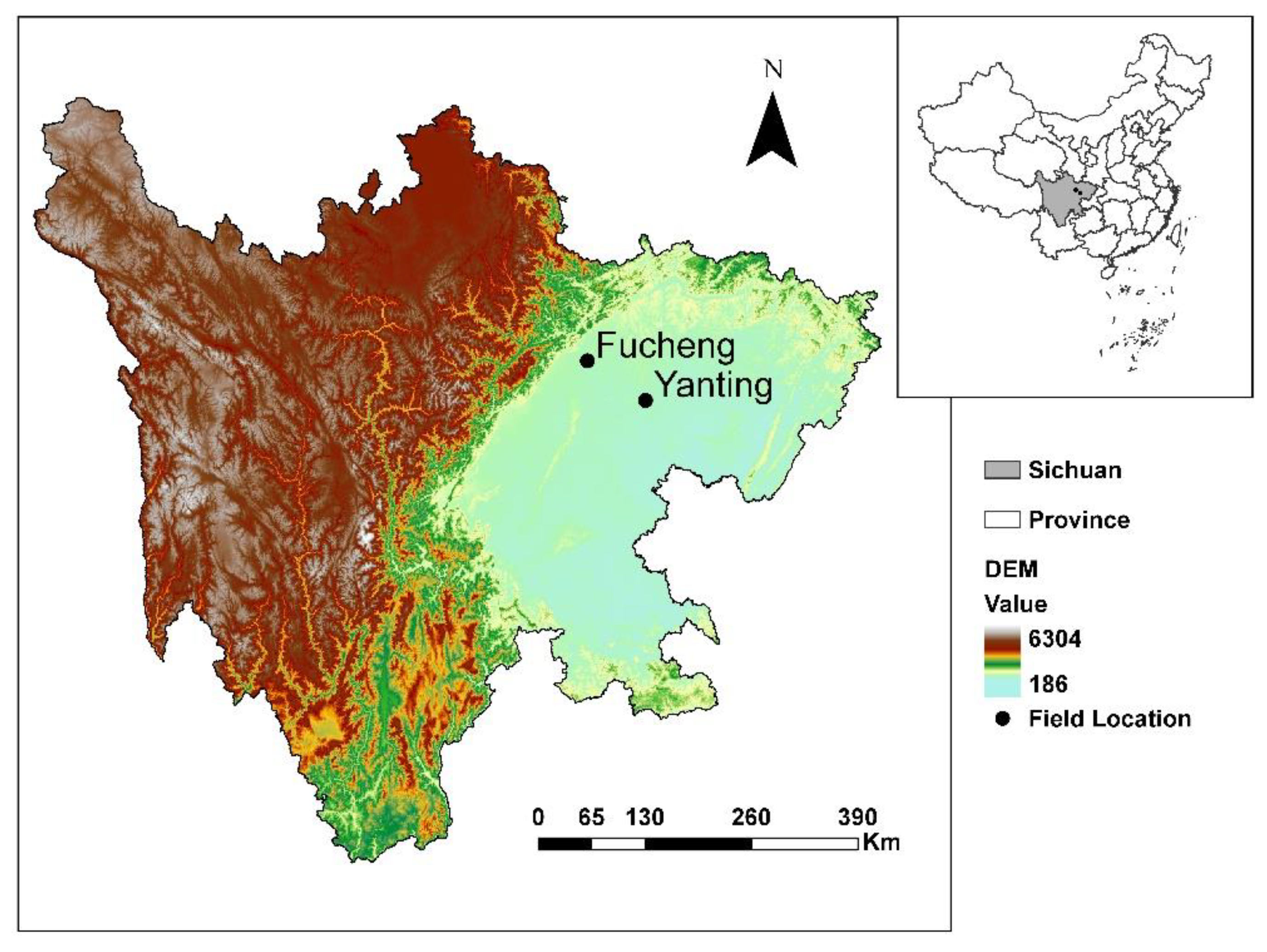
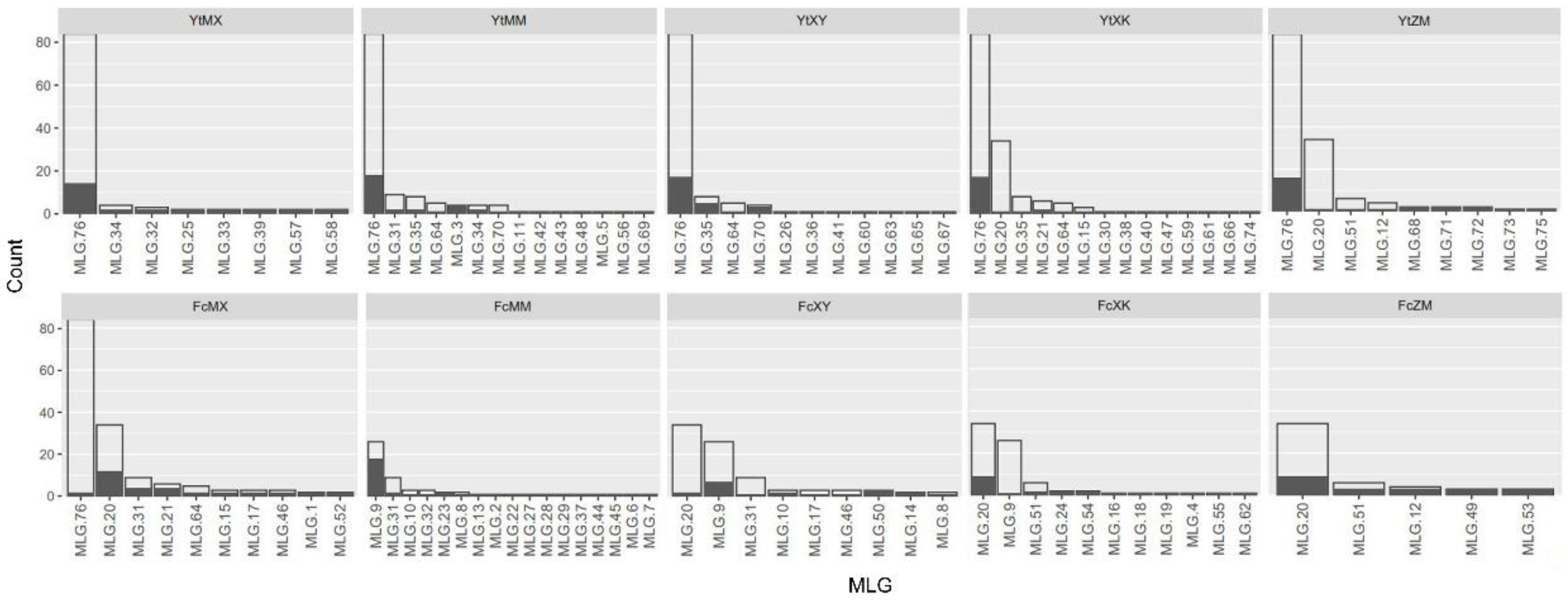
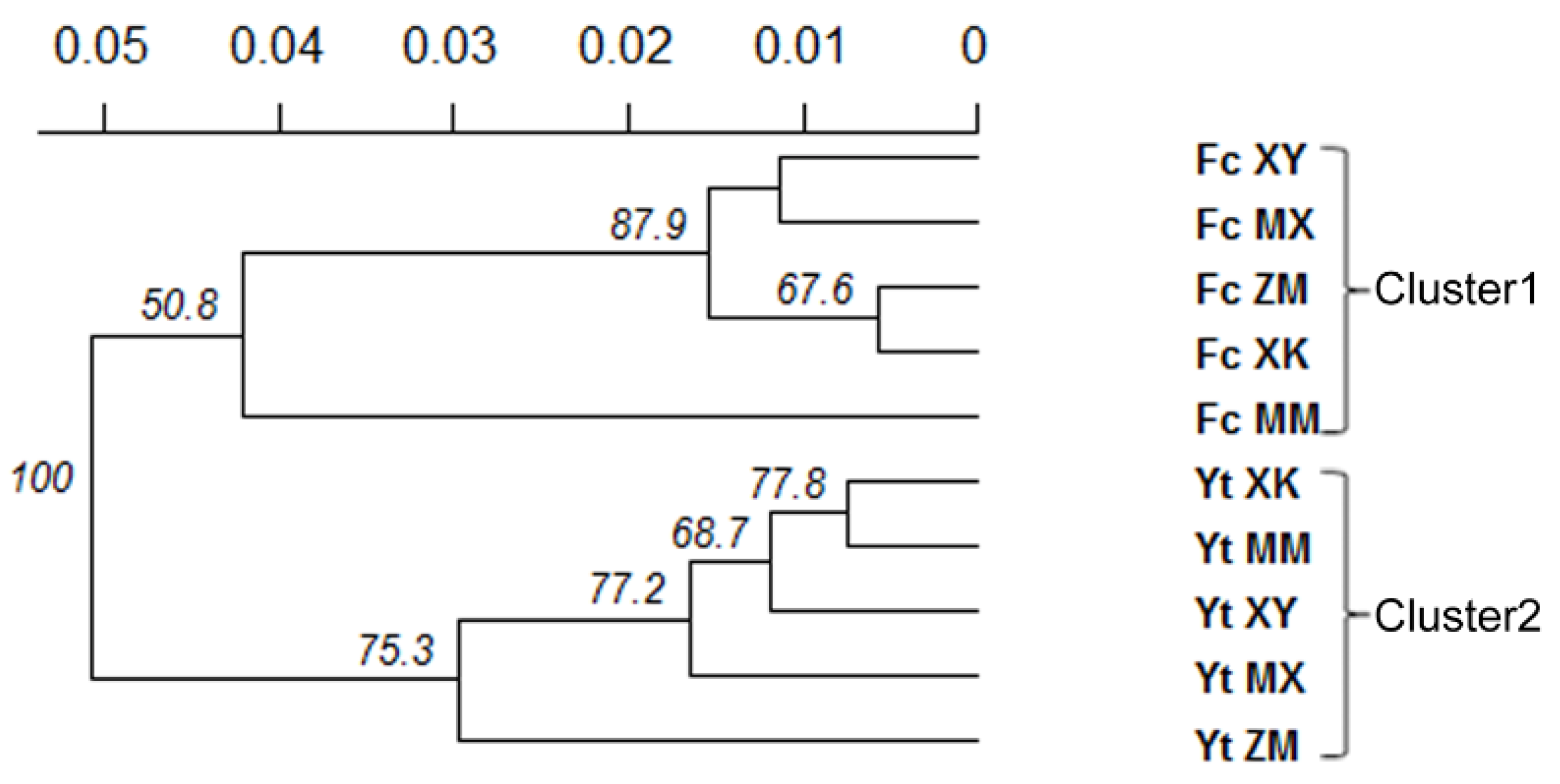
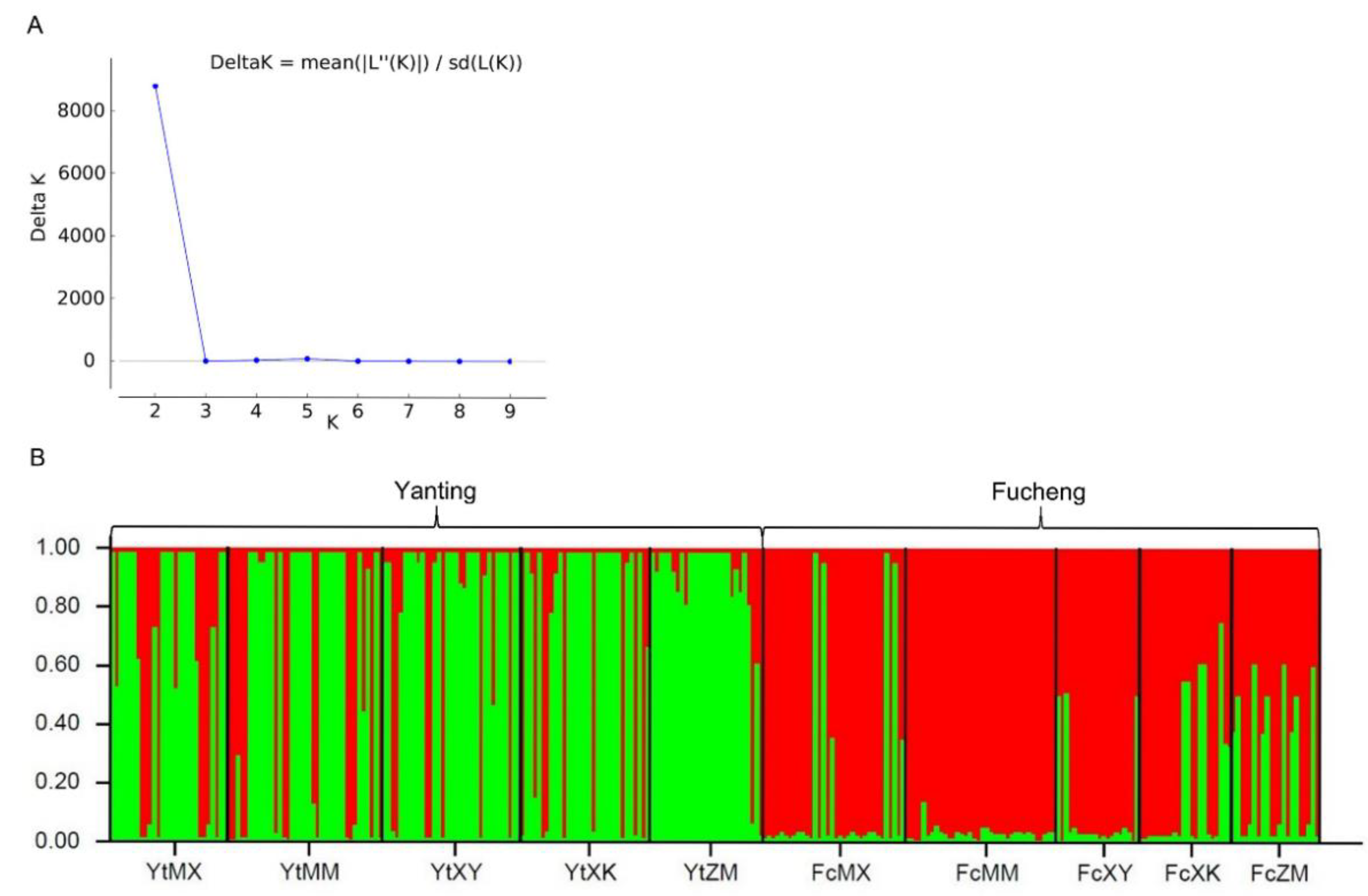
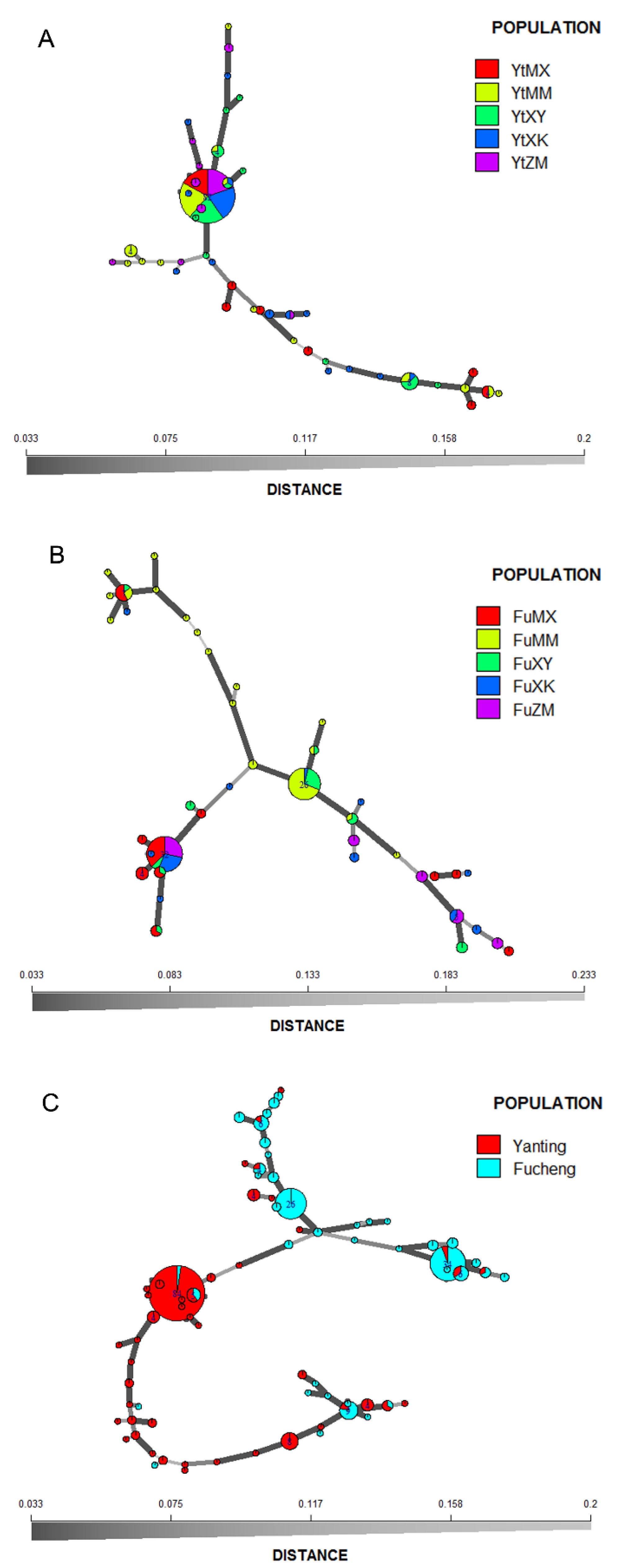
| No. | Cultivars | Infection Types (ITs) | Disease Index (DI) ± SE | |
|---|---|---|---|---|
| Yanting | Fucheng | |||
| 1 | Mingxian 169 | 4 | 23.30 ± 2.17 a | 22.74 ± 5.58 a |
| 2 | Mianmai 367 | 1–3 | 1.35 ± 0.19 c | 5.08 ± 0.94 c |
| 3 | Xikemai 4 | 1–3 | 1.61 ± 0.34 c | 1.59 ± 0.47 d |
| 4 | Xiaoyan 22 | 2–4 | 5.65 ± 0.80 b | 15.41 ± 2.70 b |
| 5 | Zhengmai 9023 | 2–3 | 4.38 ± 0.60 bc | 5.34 ± 0.41 c |
| Location | Host (Cultivar Names) | Population Code | n | Na | Ne | MLG | eMLG | H | E5 | Hexp | rbarD |
|---|---|---|---|---|---|---|---|---|---|---|---|
| Yanting | Mingxian 169 | YtMX | 28 | 2.07 ± 0.12 | 1.44 ± 0.08 | 8 | 7.48 ± 0.63 | 1.67 | 0.58 | 0.28 | 0.65 * |
| Mianmai 367 | YtMM | 37 | 2.20 ± 0.11 | 1.48 ± 0.08 | 14 | 9.22 ± 1.35 | 1.94 | 0.47 | 0.31 | 0.47 * | |
| Xikemai 4 | YtXK | 31 | 2.20 ± 0.11 | 1.32 ± 0.05 | 14 | 9.62 ± 1.31 | 1.84 | 0.41 | 0.23 | 0.48 * | |
| Xiaoyan 22 | YtXY | 33 | 2.00 ± 0.10 | 1.32 ± 0.04 | 11 | 7.79 ± 1.22 | 1.69 | 0.52 | 0.24 | 0.76 * | |
| Zhengmai 9023 | YtZM | 27 | 1.80 ± 0.15 | 1.10 ± 0.03 | 9 | 7.52 ± 0.93 | 1.50 | 0.48 | 0.08 | 0.32 * | |
| Yanting | 156 | 2.05 ± 0.05 | 1.33 ± 0.03 | 45 | 9.64 ± 0.93 | 2.39 | 0.25 | 0.24 | 0.52 * | ||
| Fucheng | Mingxian 169 | FcMX | 34 | 2.20 ± 0.11 | 1.51 ± 0.11 | 10 | 8.82 ± 0.87 | 2.04 | 0.70 | 0.30 | 0.46 * |
| Mianmai 367 | FcMM | 36 | 2.13 ± 0.10 | 1.50 ± 0.10 | 17 | 10.40 ± 1.46 | 2.06 | 0.40 | 0.31 | 0.70 * | |
| Xikemai 4 | FcXK | 22 | 2.20 ± 0.15 | 1.44 ± 0.11 | 11 | 10.35 ± 0.64 | 2.00 | 0.60 | 0.26 | 0.30 * | |
| Xiaoyan 22 | FcXY | 20 | 2.20 ± 0.11 | 1.45 ± 0.14 | 9 | 9.00 ± 0.00 | 1.94 | 0.74 | 0.26 | 0.32 * | |
| Zhengmai 9023 | FcZM | 21 | 1.73 ± 0.15 | 1.43 ± 0.13 | 5 | 5.00 ± 0.00 | 1.48 | 0.82 | 0.24 | 0.25 * | |
| Fucheng | 133 | 2.09 ± 0.06 | 1.47 ± 0.05 | 40 | 11.95 ± 1.86 | 2.94 | 0.46 | 0.30 | 0.32 * | ||
| Total | 289 | 2.07 ± 0.04 | 1.40 ± 0.03 | 76 | 12.11± 1.97 | 3.20 | 0.34 | 0.32 | 0.31 * |
| Source | d.f. | SS | PV (%) | p |
|---|---|---|---|---|
| Among geographical locations | 1 | 206.77 | 25.24% | 0.001 |
| Among host populations | 8 | 73.17 | 4.48% | 0.001 |
| Among individuals | 279 | 603.69 | 9.20% | 0.001 |
| Within individuals | 289 | 480.50 | 61.08% | 0.001 |
| Yanting | Fucheng | |||||||||
|---|---|---|---|---|---|---|---|---|---|---|
| YtMX | YtMM | YtXY | YtXK | YtZM | FcMX | FcMM | FcXY | FcXK | FcZM | |
| YtMX | ||||||||||
| YtMM | 0.009 | |||||||||
| YtXY | 0.001 | 0.018 | ||||||||
| YtXK | 0.007 | 0.005 | 0.000 | |||||||
| YtZM | 0.114 * | 0.091 | 0.066 | 0.044 | ||||||
| FcMX | 0.220 * | 0.180 * | 0.278 * | 0.232 * | 0.402 * | |||||
| FcMM | 0.328 * | 0.245 * | 0.372 * | 0.345 * | 0.478 * | 0.169 * | ||||
| FcXY | 0.313 * | 0.222 * | 0.366 * | 0.320 * | 0.504 * | 0.086 * | 0.032 | |||
| FcXK | 0.246 * | 0.176 * | 0.302 * | 0.244 * | 0.429 * | 0.017 | 0.134 * | 0.033 | ||
| FcZM | 0.233 * | 0.152 * | 0.283 * | 0.221 * | 0.400 * | 0.052 | 0.134 * | 0.036 | 0.000 | |
Publisher’s Note: MDPI stays neutral with regard to jurisdictional claims in published maps and institutional affiliations. |
© 2022 by the authors. Licensee MDPI, Basel, Switzerland. This article is an open access article distributed under the terms and conditions of the Creative Commons Attribution (CC BY) license (https://creativecommons.org/licenses/by/4.0/).
Share and Cite
Wang, S.; Gao, C.; Sun, Q.; Liu, Q.; Wang, C.; Guo, F.; Ma, Z. Genetic Characterization of Puccinia striiformis f. sp. tritici Populations from Different Wheat Cultivars Using Simple Sequence Repeats. J. Fungi 2022, 8, 705. https://doi.org/10.3390/jof8070705
Wang S, Gao C, Sun Q, Liu Q, Wang C, Guo F, Ma Z. Genetic Characterization of Puccinia striiformis f. sp. tritici Populations from Different Wheat Cultivars Using Simple Sequence Repeats. Journal of Fungi. 2022; 8(7):705. https://doi.org/10.3390/jof8070705
Chicago/Turabian StyleWang, Shuhe, Chaofan Gao, Qiuyu Sun, Qi Liu, Cuicui Wang, Fangfang Guo, and Zhanhong Ma. 2022. "Genetic Characterization of Puccinia striiformis f. sp. tritici Populations from Different Wheat Cultivars Using Simple Sequence Repeats" Journal of Fungi 8, no. 7: 705. https://doi.org/10.3390/jof8070705
APA StyleWang, S., Gao, C., Sun, Q., Liu, Q., Wang, C., Guo, F., & Ma, Z. (2022). Genetic Characterization of Puccinia striiformis f. sp. tritici Populations from Different Wheat Cultivars Using Simple Sequence Repeats. Journal of Fungi, 8(7), 705. https://doi.org/10.3390/jof8070705






